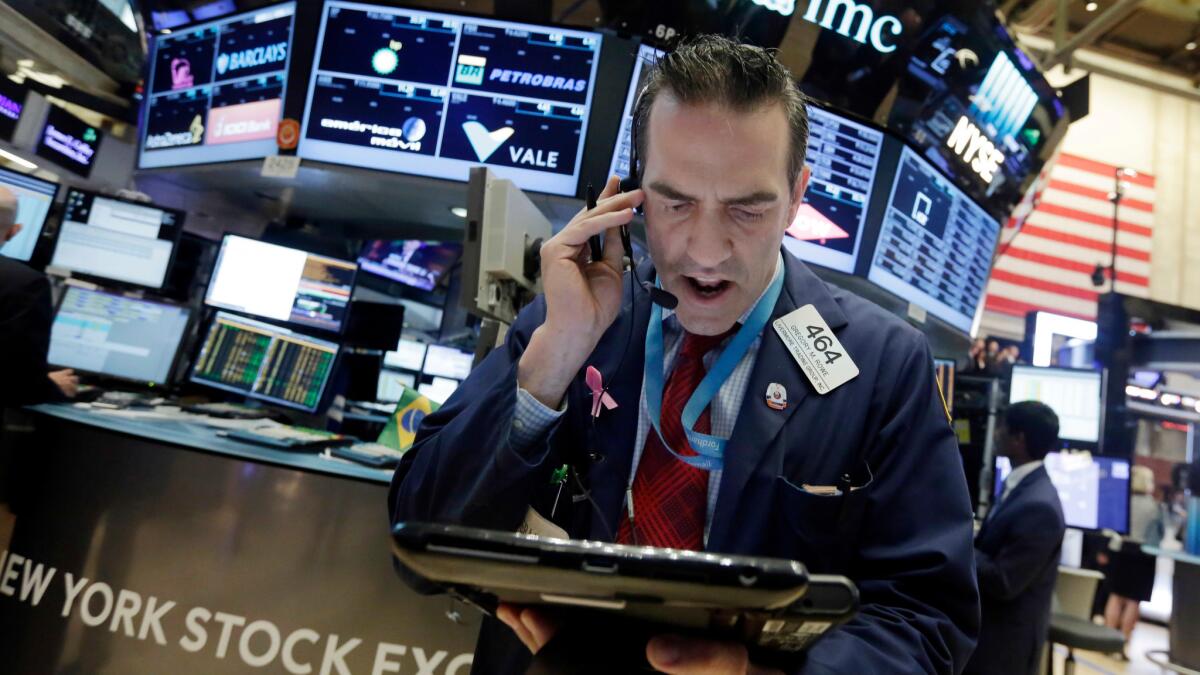Ever-lower interest rates leave investors with tough choices

- Share via
Fresh worries about the global economy’s health this year have forced many investors to embrace uncomfortable strategies with their money.
On one hand, with decent growth investments hard to find, investors are paying high prices relative to earnings for stocks that seem to provide some certainty. That’s evident in shares of utilities, many of which offer slow but steady profit growth and decent dividends.
The Dow utility stock index is up a stunning 24% this year, compared with 4.2% for the blue-chip Standard & Poor’s 500 index. That also means utility stocks no longer are cheap.
Meanwhile, fears of a deeper economic slowdown have pushed some investors to pile into high-quality bonds as a haven. That demand has driven yields on many government bonds to record lows. The 10-year U.S. Treasury note yield ended at 1.37% on Friday, down from 2.27% at the end of last year.
In Japan and Europe, markets are so nervous that yields on many government bonds now are slightly negative -- which means bond owners actually pay the government to hold their money.
As bond yields have continued to fall since 2008, investors have been repeatedly warned to avoid longer-term securities because of the risk that yields could boomerang. As soon as the global economy rebounds convincingly, the thinking goes, long-term interest rates will jump. So, wait to buy, to lock in higher yields.
But a convincing global economic rebound has never arrived and remains elusive. That begins to explain how, even with Treasury yields at such paltry levels, investors still can justify buying.
What’s more, negative yields on government bonds in Europe and Japan mean U.S. bond yields, even below 1.5%, are relatively attractive for European and Japanese investors. That helped explain why U.S. bond yields fell further Friday even though the government reported surprisingly robust June job gains, after hiring had slowed sharply in April and May.
Jeffrey Rosenberg, chief investment strategist for fixed income at money management firm BlackRock Inc., said investors have had to rethink bonds’ role in a portfolio.
“Bonds aren’t held in isolation,” he noted. They’re typically part of a diversified portfolio of assets that includes stocks; those equities represent a bet on the economy continuing to grow, even if slowly. But if the investor also wants some insurance in the portfolio against the economy worsening, adding long-term government bonds may make the most sense despite current low yields.
If the economic outlook deteriorates, nothing precludes long-term Treasury bond yields from going lower, in turn boosting the value of older bonds. By contrast, if an investor holds short-term bonds, their value would rise much less if short-term rates fell further, Rosenberg notes.
Short-term bonds “don’t go down much [in value], but they don’t go up much either,” he said.
Long-term bonds “are an insurance policy, and like all insurance policies they come with a price,” Rosenberg said. One element of the price is minimal yields. The other element is what bonds could cost in lost market value if interest rates ever do go up significantly and stay up.
But even then, Treasury bond investors know they still have the option of at least getting back the bonds’ full face value -- if they’re willing to hold them to maturity.
As for stocks, the market rallied broadly on Friday after the June jobs report. The Dow Jones industrial average gained 250.86 points, or 1.4%, to 18,146.74. The S&P 500 rose 1.5% to 2,129.90, just a hair below its all-time high reached in May 2015.
Still, many stocks have struggled over the last year amid a continued decline in overall corporate earnings, after years of booming profit growth. Weak earnings are a direct byproduct of the anemic global economy.
First-quarter operating earnings for the S&P 500 companies were down about 5% from a year earlier, the third straight quarterly decline, data firm Thomson Reuters I/B/E/S said. Second-quarter results are expected to be off 4.8% from a year earlier, according to analyst estimates tracked by Thomson.
Earnings ultimately support share prices, which is why many investors have been wary of the market this year, preferring bonds instead. Optimists, however, believe that profits will begin to rebound for many companies in the second half of the year, supporting another advance in share prices.
But Bank of America Merrill Lynch, among others, is skeptical of a significant earnings recovery soon. The firm on Friday further cut its corporate profit expectations, projecting no net growth in S&P 500 earnings this year. It cited the threat of more economic weakness in the rest of the world -- particularly in Europe, given Britain’s decision to leave the European Union.
While stocks are again nearing all-time highs, “the profits recovery is unlikely to live up to expectations,” BofA Merrill warned.
ALSO
Another financial crisis? Soaring global debt since 2008 raises risk as world economy sputters
‘Brexit’ boosts mortgage applications; Milken as mythic hero
Stocks close near record high, fueled by strong jobs report
More to Read
Inside the business of entertainment
The Wide Shot brings you news, analysis and insights on everything from streaming wars to production — and what it all means for the future.
You may occasionally receive promotional content from the Los Angeles Times.










